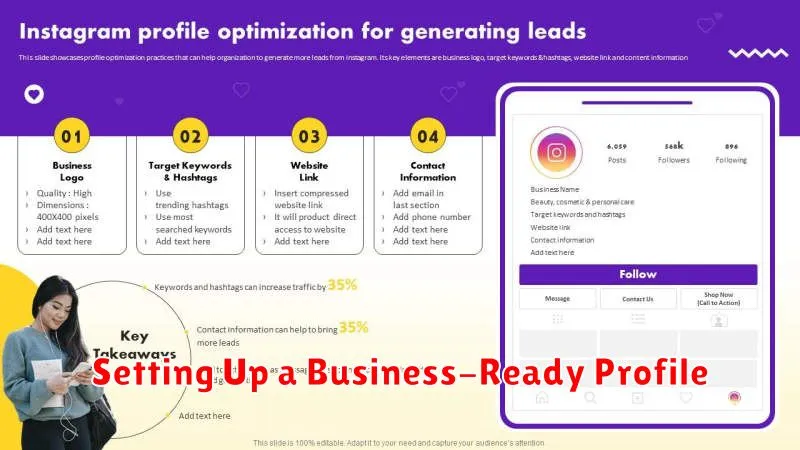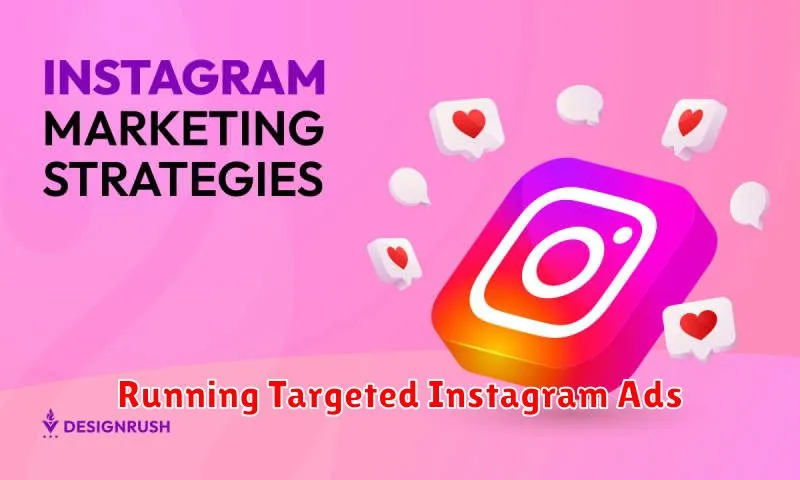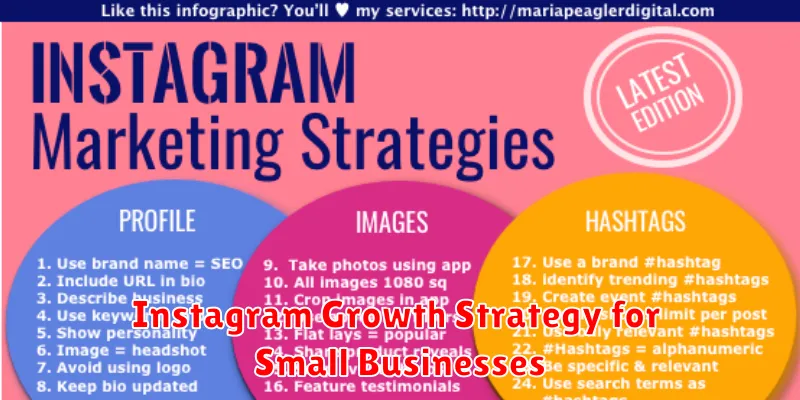Are you a small business owner looking to expand your reach and boost your brand visibility? In today’s digital age, a robust Instagram presence is no longer optional, but essential. This article outlines a comprehensive Instagram growth strategy specifically designed for small businesses. We’ll delve into actionable tactics to organically increase your followers, amplify engagement, and ultimately drive sales. Learn how to leverage Instagram’s powerful platform to connect with your target audience, build a thriving online community, and achieve tangible business growth. Focus on developing a winning Instagram marketing strategy that aligns with your overall business objectives and sets you up for long-term success.
From crafting compelling content and utilizing relevant hashtags to understanding Instagram analytics and running effective Instagram ads, this guide covers all the key aspects of Instagram growth. Discover how to optimize your Instagram profile, create visually appealing content that resonates with your ideal customer, and master the art of Instagram engagement. Whether you’re just starting out or looking to refine your existing strategy, this article will provide you with valuable insights and practical tips to elevate your small business’s Instagram presence and achieve significant growth.
Why Instagram Is Still Powerful for Brands
Instagram remains a highly effective platform for brands to connect with their target audience. With a massive user base actively engaged in visual content, businesses can leverage Instagram’s visual-first nature to showcase products, services, and brand storytelling in a compelling way. The platform’s diverse advertising options, including sponsored posts, stories, and influencer marketing, allow brands to reach specific demographics and achieve measurable results. Instagram’s shopping features also facilitate direct sales, streamlining the customer journey from discovery to purchase. The platform’s focus on community building through features like Reels, live sessions, and interactive stickers enables brands to foster authentic relationships with their followers, increasing brand loyalty and advocacy.
Beyond its substantial reach, Instagram offers valuable insights into audience behavior and preferences. Brands can utilize analytics tools to understand what resonates with their followers, optimize content strategy, and track campaign performance. This data-driven approach enables businesses to refine their targeting, messaging, and creative execution for maximum impact. Furthermore, Instagram’s algorithm prioritizes engaging content, rewarding brands that consistently deliver high-quality visuals and cultivate meaningful interactions with their audience. This organic reach potential offers a significant advantage for brands seeking to build a strong online presence.
In addition to its core features, Instagram continuously evolves to incorporate new trends and technologies, ensuring its continued relevance in the ever-changing social media landscape. The platform’s integration with other Meta platforms, such as Facebook, allows for seamless cross-promotion and expanded reach. The embrace of features like augmented reality filters and short-form video formats like Reels demonstrates Instagram’s commitment to providing brands with innovative tools to captivate their audience and drive business growth. By adapting to emerging trends and offering cutting-edge features, Instagram solidifies its position as a powerful marketing tool for brands of all sizes.
Setting Up a Business-Ready Profile

Creating a professional online presence is essential for business success. A business-ready profile projects credibility and competence, attracting potential clients, partners, and employers. This involves carefully curating your information across various platforms, ensuring consistency and accuracy. Key elements of a strong profile include a professional headshot, a concise and compelling summary highlighting your skills and experience, and a complete employment history.
Maintaining a consistent brand across different platforms is crucial. Use the same professional headshot and similar language in your summaries and bios. Regularly update your information to reflect your current skills and accomplishments. Actively engage with your network by sharing relevant content and participating in industry discussions. This helps build your reputation as a knowledgeable and engaged professional.
Consider the platform-specific best practices. For example, LinkedIn is ideal for showcasing your professional experience and connecting with colleagues, while Twitter can be used to share industry insights and engage in public conversations. Tailoring your profile to each platform maximizes its effectiveness and reach. Remember to regularly review and update your privacy settings to ensure you are comfortable with the information you are sharing.
Developing a Strong Visual Style
A strong visual style is crucial for effective communication and brand recognition. It encompasses a consistent application of design elements such as typography, color palettes, imagery, and composition. A well-defined visual style creates a cohesive and memorable experience for the audience, reinforcing brand identity and enhancing message clarity.
Developing a robust visual style requires careful consideration of the target audience and the brand’s core values. Researching competitors and identifying trends can provide valuable insights. Key considerations include choosing fonts that are both legible and reflective of the brand’s personality, selecting a color palette that evokes the desired emotions, and curating imagery that aligns with the overall message. Consistency in applying these elements across various platforms and mediums is paramount.
Maintaining a consistent visual style requires establishing clear brand guidelines that document the approved design elements and their usage. These guidelines serve as a reference for all stakeholders involved in creating visual content, ensuring that the brand’s visual identity remains consistent and recognizable across all touchpoints. Regular audits and updates to the guidelines are necessary to adapt to evolving trends and maintain a fresh and relevant visual presence.
Content Calendar Planning
A content calendar is a strategic tool used to plan and schedule all content marketing activities. It provides a centralized view of upcoming blog posts, social media updates, email campaigns, and other content pieces. Effective content calendar planning ensures consistent publishing, supports broader marketing goals, and allows for proactive adjustments to content strategy based on performance and audience engagement.
Creating a content calendar involves identifying key themes and topics relevant to your target audience. It’s crucial to consider seasonal events, industry trends, and company-specific promotions when scheduling content. The calendar should outline publishing dates, content formats, assigned authors or teams, and target distribution channels. This organized approach streamlines content creation workflows and improves team collaboration.
Utilizing a content calendar provides several key benefits. It helps maintain a consistent brand voice and messaging across all platforms. It facilitates performance tracking and analysis, enabling data-driven decision making. Furthermore, it promotes proactive planning for future campaigns, ensuring that content remains timely and relevant.
Leveraging Reels and Carousels

Reels and carousels are powerful tools for engaging your audience on social media platforms like Instagram and Facebook. Reels, with their short-form video format, are ideal for grabbing attention and showcasing your brand’s personality through entertaining and informative content. Think quick tutorials, behind-the-scenes glimpses, and trending audio usage to maximize reach. Carousels, on the other hand, allow for deeper dives into topics by presenting multiple images or videos within a single post. They’re perfect for sharing step-by-step guides, product highlights, or telling a story that unfolds as users swipe.
Using these formats effectively requires a strategy. For Reels, focus on high-quality video and engaging audio. Keep them concise and visually appealing to hold viewers’ attention. With carousels, ensure each image or video contributes to the overall narrative. Use clear and concise captions to guide your audience through the content. A strong call to action in both formats encourages engagement and drives results.
By understanding the strengths of each format and tailoring your content accordingly, you can effectively leverage Reels and carousels to boost your brand’s visibility, engagement, and ultimately, your bottom line. Experiment with different approaches and analyze your results to identify what resonates best with your audience. Consistent posting and interaction are key to building a strong presence and maximizing the impact of your Reels and carousel content.
Using Hashtags Intentionally
Hashtags are a powerful tool for increasing visibility and engagement on social media platforms. They categorize your content, making it easier for users interested in specific topics to find it. Using relevant hashtags helps connect your posts with a wider audience beyond your existing followers. Think carefully about the keywords that best represent your content and align with your target audience’s interests. Avoid using too many hashtags, as this can appear spammy and dilute their effectiveness.
Research popular and trending hashtags within your niche. Tools are available to help identify relevant hashtags and analyze their performance. While trending hashtags can offer broader reach, don’t neglect niche hashtags that can connect you with a more engaged and targeted audience. Consider creating a branded hashtag unique to your business or campaign to build community and track conversations around your brand.
Analyze the performance of your hashtags to refine your strategy. Most platforms provide insights into hashtag reach and engagement. Pay attention to which hashtags are driving the most impressions, clicks, and interactions. Regularly reviewing and adjusting your hashtag usage based on this data will ensure you are reaching the right audience and maximizing your social media impact.
Collaborations with Micro-Influencers
Micro-influencers, typically with follower counts between 10,000 and 100,000, offer a unique opportunity for brands. They cultivate highly engaged audiences built on trust and authenticity. This translates into higher conversion rates and more genuine interactions compared to collaborations with macro-influencers. Micro-influencers often specialize in a niche, allowing brands to target specific demographics effectively and reach a truly interested audience.
Partnering with micro-influencers can be significantly more cost-effective than engaging larger influencers. Their rates tend to be lower, offering better return on investment, particularly for smaller businesses or those with focused marketing budgets. This allows brands to experiment with different campaign styles and potentially collaborate with multiple micro-influencers for broader reach. The stronger connection they have with their followers often leads to authentic and impactful content that resonates deeply within their community.
When considering collaborations, it’s crucial to carefully vet potential micro-influencers. Look beyond follower count and focus on engagement rates, audience demographics, and content quality. Ensure their values align with your brand and that their content is genuinely engaging and relevant to their audience. A true partnership requires open communication and collaboration between the brand and the micro-influencer to ensure a successful campaign.
Running Targeted Instagram Ads

Instagram ads offer a powerful way to reach specific audiences and achieve your marketing goals. By leveraging Instagram’s detailed targeting options, you can connect with users based on demographics, interests, behaviors, and even custom audiences you create. This precision allows you to focus your ad spend on users who are most likely to engage with your content and convert into customers. Defining your objective is the first step. Do you want to increase brand awareness, drive traffic to your website, or generate leads? Clearly defining your goal will help you tailor your ad creative and select the appropriate campaign metrics to track.
Setting up your targeted Instagram ad campaign involves several key steps. First, choose your ad format, whether it’s an image, video, carousel, or story. Then, define your target audience using Instagram’s robust targeting parameters. You can select demographics like age, gender, and location, as well as interests such as fashion, food, or travel. Consider using custom audiences to retarget website visitors or engage existing customers. Finally, set your budget and bidding strategy. You can choose a daily or lifetime budget and opt for automatic or manual bidding. Regularly monitoring your campaign performance is crucial for optimizing your ads and ensuring you achieve the desired results.
Tracking and analyzing your campaign performance is essential for maximizing your return on ad spend. Key metrics to monitor include reach, impressions, engagement (likes, comments, shares), website clicks, and conversions. By analyzing these metrics, you can identify what’s working and what’s not. Use this data to refine your targeting, adjust your ad creative, and optimize your bidding strategy. Continuous optimization is key to ensuring your Instagram ad campaigns are effective and deliver a positive ROI.
Tracking Growth with Insights
Tracking growth is crucial for any business or individual seeking improvement. Whether you’re monitoring sales figures, personal fitness goals, or social media engagement, consistent tracking provides valuable insights. These insights illuminate what’s working, what needs adjustment, and ultimately, how to achieve desired outcomes. By regularly collecting and analyzing data, you can identify trends, pinpoint areas of strength and weakness, and make informed decisions to optimize performance.
Key metrics to track will vary depending on your specific goals. Businesses might focus on revenue, customer acquisition cost, and market share. Individuals pursuing personal development might track habits, skills learned, or progress toward specific objectives. Regardless of the area of focus, choose metrics that are measurable, relevant, and actionable. This ensures the collected data translates into tangible improvements and helps drive progress.
Several tools and methods facilitate effective tracking. Spreadsheets, specialized software, and even simple notebooks can be used to record and analyze data. The key is to choose a system that fits your needs and allows for consistent data entry. Remember to regularly review and analyze your tracked data. This process of reflection is where the true value of tracking lies. By understanding the “why” behind the numbers, you can unlock the power of insights to drive continuous growth and achieve your goals.
Mistakes to Avoid on Instagram
One of the most common mistakes on Instagram is posting low-quality content. This includes blurry photos, poorly lit videos, and uninspired captions. Think of your feed as a portfolio showcasing your brand or personality. Ensure each post adds value and is visually appealing to keep your audience engaged. Prioritize high-resolution images and videos that are well-composed and tell a story. Crafting compelling captions that are informative, witty, or thought-provoking can also significantly elevate your content.
Another pitfall is neglecting engagement with your followers. Instagram is a social platform, so interaction is key. Responding to comments and direct messages shows you value your audience and fosters a sense of community. Actively engaging with other users’ content by liking, commenting, and sharing can also expand your reach and attract new followers. Remember, building a strong presence on Instagram requires genuine connection, not just broadcasting your own content.
Finally, avoid the mistake of ignoring your analytics. Instagram provides valuable insights into your audience demographics, post performance, and engagement rates. Utilizing this data can inform your content strategy and help you tailor your posts to resonate with your target audience. Understanding which content performs well and which falls flat allows you to optimize your approach and maximize your impact on the platform.

